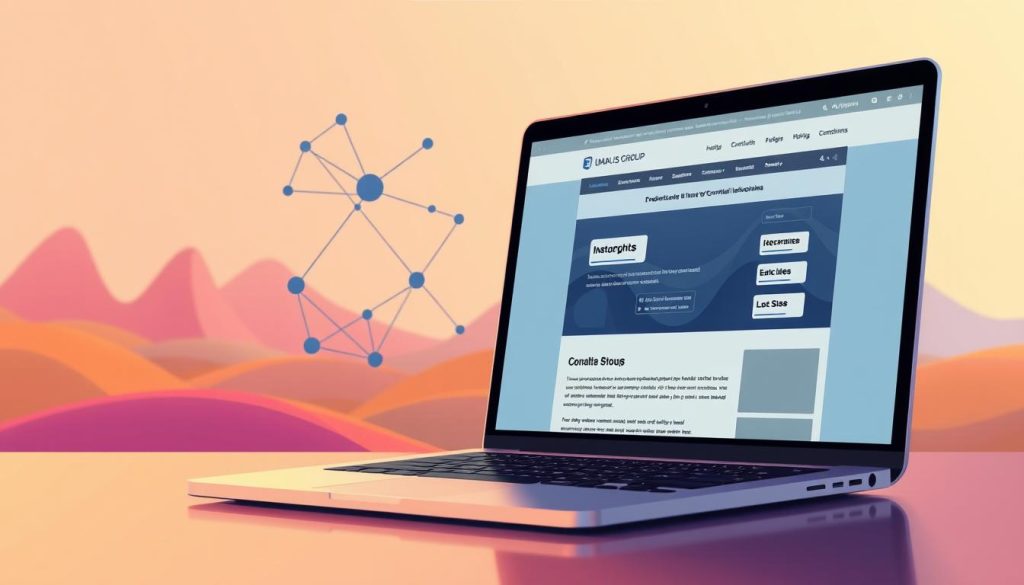Have you ever felt like your carefully crafted website content gets lost in the digital void? I remember launching my first professional blog years ago, pouring hours into creating valuable resources, only to watch pages gather dust in search results. That sinking feeling of wasted effort changed when I discovered the quiet power of strategic connections within a website.
Like signposts in a bustling city, well-placed links guide both visitors and search engines through your digital space. These connections do more than just help users navigate – they whisper to Google about your most important pages, creating a roadmap that boosts visibility. Imagine transforming your site from a collection of isolated pages into a thriving ecosystem where every piece of content supports and elevates the others.
This approach isn’t just about technical SEO. It’s about creating meaningful pathways that serve your audience while strengthening your online presence. When done right, these connections can increase engagement by up to 20% while making your entire website more discoverable. The best part? You hold all the tools to implement this strategy today.
We’ll walk through practical methods to optimize your content connections while maintaining professional integrity. You’ll learn how to balance user needs with search engine requirements, creating a sustainable foundation for growth.
Table of Contents
Key Takeaways
- Strategic connections between pages improve both user experience and search visibility
- Google uses website pathways to understand content hierarchy and importance
- Properly implemented links can significantly reduce bounce rates
- This method gives website owners direct control over their SEO success
- Balanced linking strategies support long-term business goals
- Clear navigation paths help visitors discover related content easily
Understanding the Role of Internal Linking in SEO
Your website’s success depends on two critical audiences: search engines and human visitors. Strategic connections between pages serve both, acting as digital breadcrumbs that guide crawlers while helping users discover valuable resources.
The Importance of Linking for Search Engines
Google’s crawlers explore your site like digital librarians. Starting at your homepage, they follow pathways to catalog every page. Pages with multiple connections signal importance—like bestsellers in a library—earning higher visibility in search results.
This process helps algorithms:
- Map relationships between related topics
- Identify priority content through link frequency
- Determine content hierarchy and depth
Enhancing User Navigation through Links
Visitors stay longer when they find clear paths to relevant information. A well-connected article about contract negotiations might guide readers to templates or case studies—keeping them engaged and reducing bounce rates.
This dual benefit creates a powerful cycle: satisfied users signal quality to search engines, which then drive more traffic. For those seeking natural link-building strategies, remember that strong onsite connections often inspire external recognition.
Defining Internal Linking in Today’s Digital Landscape

Modern websites thrive on meaningful connections between their content pieces. These pathways – hyperlinks directing users to related pages – create organized networks that benefit both visitors and search algorithms. Unlike external references, these connections remain within your digital property, strengthening its structural foundation.
- Menu pathways: Persistent links in headers/sidebars guiding to core pages
- Content bridges: Text-embedded references (contextual links) enhancing topic depth
- Visual gateways: Clickable images directing to supporting resources
- Footer signposts: Bottom-of-page links for policies or contact details
- Location markers: Breadcrumb trails showing page hierarchy
- Action prompts: Strategic CTAs driving conversions mid-content
Contextual links blend naturally into your text, offering value through relevant suggestions. Unlike menu links designed for general navigation, these content bridges demonstrate topical relationships to search engines. A recipe page might connect to « seasonal ingredient guides » using descriptive anchor text like « spring vegetable preparation techniques ».
Effective strategies use multiple connection types without overwhelming users. Footer links work best for legal pages, while sidebar options suit recurring tools. Breadcrumbs help visitors track their journey, especially in complex sites. Each format serves distinct purposes – mixing them creates layered navigation that satisfies both technical requirements and human curiosity.
Building an Effective Site Structure for Internal Links
Just as a well-designed building needs a blueprint, your digital presence requires intentional organization. A clear framework helps visitors find value quickly while signaling content priorities to search algorithms. Let’s explore how to construct this foundation.
The Pyramid Model of Website Organization
Think of your site as a three-tiered pyramid. The homepage sits at the peak, acting as your digital front door. Directly beneath lie primary categories—your core services or content pillars. Individual posts and resources form the base, connected through logical subcategories.
| Structure Type | User Impact | SEO Benefit |
|---|---|---|
| Pyramid | 3-click access to all pages | Improved crawl efficiency |
| Flat | Confusing navigation | Wasted link equity |
| Web-like | Overwhelming choices | Diluted page authority |
Creating a Clear Navigation and Sitemap
Your menu should mirror your pyramid’s hierarchy. Limit top-level options to 5-7 essential categories. Use dropdowns sparingly—each submenu item should serve a specific purpose. As one digital architect notes: « Confused visitors become former visitors faster than you can say ‘back button.' »
Combine this with a strategic content plan to reinforce connections between related topics. Breadcrumb trails and footer links provide secondary pathways without cluttering primary navigation. Remember: every click saved is engagement gained.
Identifying Key Content and Cornerstone Pages
Imagine your website as a library—where are the bestselling books? Your cornerstone content represents these prized volumes: comprehensive resources that showcase your expertise. These pages become digital anchors, attracting visitors and search algorithms through their depth and relevance.
Selecting High-Value Pages for Link Distribution
Start by auditing existing material. Look for pages that:
- Address primary services or products
- Generate consistent organic traffic
- Convert visitors at higher rates
Pillar pages act as central hubs, linking to cluster pages that explore subtopics. For example, a freelance contract guide might connect to specialized articles about negotiation tactics or payment terms.
| Cornerstone Page Traits | Cluster Page Traits |
|---|---|
| 2,000+ words | 500-800 words |
| Covers broad topics | Focuses on specific questions |
| Receives 15+ internal links | Links back to pillar content |
As SEO strategist Mara Thompson notes: « Link equity flows like water—direct it to your deepest wells. » Prioritize pages that demonstrate thought leadership, ensuring they receive strategic connections from related articles.
Balance remains crucial. While pillar pages need multiple links, supporting content requires pathways too. This creates a network where authority circulates naturally, boosting rankings while helping users discover related resources.
Strategies for Optimizing Internal Linking

What makes visitors click while keeping search algorithms engaged? The answer lies in how you label your digital pathways. Clear, descriptive labels act as tour guides through your content – they tell users what to expect while helping search systems map relationships.
Crafting Clickable Text That Works
Your clickable phrases should function like street signs – specific enough to guide, but natural enough to blend into the surroundings. Instead of repetitive labels like « click here, » try descriptive phrases that preview the destination. For example: « Download our freelance contract template » tells both users and algorithms exactly what awaits them.
| Anchor Type | Purpose | Example |
|---|---|---|
| Optimized | Target specific search terms | « Portage salarial benefits » |
| Natural | Blend with surrounding text | « As outlined in our pricing guide » |
| Generic | Direct without keywords | « Learn more about tax planning » |
Smart Use of Link Attributes
Most connections should pass authority to other pages (followed). However, strategic use of nofollow tags helps manage equity distribution. Consider adding them to:
- Duplicate content pages
- Testimonial sections
- Older archived material
Search systems now analyze surrounding sentences to assess relevance. A well-crafted backlinking strategy complements your onsite connections by demonstrating external validation. Remember: natural variety in clickable text creates trust with both visitors and algorithms.
Implementing Contextual and Navigational Links

Every click on your site should feel like a natural step forward, not a dead end. Strategic connections guide visitors through your digital space while telling search engines which pages deserve attention. Let’s explore two powerful methods to create these pathways.
Embedding Contextual Links in Content
Contextual links act like helpful suggestions within your text. When discussing freelance contracts, you might connect to a « client onboarding checklist » using descriptive anchor text. These connections:
- Appear naturally where readers need more information
- Strengthen topical authority by linking related subjects
- Pass 30% more SEO value than menu links
Search systems analyze surrounding text to assess relevance. A guide about tax planning linking to « quarterly payment deadlines » shows clear content relationships. This approach works best when links feel organic – like a conversation rather than a sales pitch.
Optimizing Menu, Footer, and Sidebar Links
Your website’s permanent navigation needs careful planning. Limit main menu items to 5-7 core pages like Services or Pricing. Sidebars work well for tools or calculators visitors might need repeatedly. Footers should house legal pages, not compete with primary content.
| Link Type | Best For | SEO Impact |
|---|---|---|
| Menu | Core service pages | High visibility |
| Sidebar | Recurring resources | Medium authority |
| Footer | Legal/contact info | Low priority |
Balance is key. While quality backlinks boost external credibility, your onsite connections determine how visitors and crawlers explore your content. Combine contextual suggestions with clear navigation to create pathways that serve both audiences.
Leveraging SEO Tools to Audit and Enhance Internal Links
In the digital toolbox, certain instruments transform how you manage website pathways. Specialized SEO platforms provide X-ray vision into your content network, revealing hidden opportunities and structural weaknesses.
Streamlining Connections with Plugin Solutions
Yoast SEO simplifies optimization with real-time feedback. Its content analysis checks:
- Link relevance to surrounding text
- Proper use of follow/nofollow attributes
- Anchor text diversity across pages
The plugin’s suggestions help maintain natural content flow while meeting technical requirements. For WordPress users, it acts like a built-in SEO consultant whispering improvements as you write.
Measuring Crawl Efficiency and Authority Flow
Advanced tools like Screaming Frog map your entire website structure. A recent case study showed sites using crawl data reduced orphaned pages by 73% within two months. Key metrics to track:
| Tool | Primary Function | Best For |
|---|---|---|
| Semrush | Authority distribution analysis | Identifying link equity gaps |
| Moz Pro | Crawl depth visualization | Optimizing navigation paths |
| Screaming Frog | Technical issue detection | Finding broken connections |
Compare crawl results with Google’s index using site:yourdomain.com searches. Discrepancies often reveal pages needing stronger connections. As one digital strategist notes: « Tools don’t replace strategy—they illuminate the path forward. »
Avoiding Common Pitfalls in Internal Linking
Even the strongest bridges collapse without maintenance. Your digital pathways require regular checks to ensure smooth journeys for visitors and search systems. Let’s explore practical solutions for maintaining error-free connections across your pages.
Keeping Pathways Functional and Efficient
Broken links act like roadblocks in your content network. These dead ends frustrate users and tell search engines your site lacks care. Regular checks using tools like professional SEO audit services help identify 404 errors before they damage credibility.
Redirect chains create unnecessary detours. When three redirects stand between users and their destination, you waste crawl budget and slow load times. Update connections directly to final URLs whenever possible.
Orphaned pages—those without incoming links—remain hidden from both visitors and search engines. Schedule monthly reviews to ensure all valuable content connects to at least one other page. This simple habit boosts discoverability while strengthening your site’s architecture.
Strategic use of nofollow tags preserves authority flow. Apply them to duplicate content areas or third-party testimonials. Remember: search systems treat these attributes differently, so use them sparingly and intentionally.
By maintaining clean pathways and intentional connections, you create a trustworthy environment that supports long-term growth. Your audience will appreciate the seamless experience, while search algorithms reward your attention to detail with improved visibility.
FAQ
How does internal linking improve search engine rankings?
Strategically placed links help search engines like Google understand your site’s hierarchy and content relationships. By guiding crawlers to high-value pages, you strengthen topic relevance and distribute link equity effectively across your website.
What’s the difference between contextual and navigational links?
Contextual links appear naturally within body content (e.g., blog posts) to deepen user engagement. Navigational links in menus, footers, or sidebars prioritize usability. Both types work together to create a balanced site structure for SEO and visitors.
Should I use exact-match keywords in anchor text?
While descriptive anchor text like “small business accounting tips” improves clarity, avoid over-optimization. Tools like Yoast SEO can help analyze your anchor diversity. Aim for relevance over rigid keyword matching to maintain natural content flow.
How many internal links should a page have?
Focus on quality over quantity. Pages like cornerstone content or service hubs may require 5-10 contextual links for optimal value distribution. Avoid cluttering pages with excessive links, which can dilute SEO impact and overwhelm users.
Why monitor crawl depth in internal linking?
Deep pages with excessive clicks from the homepage risk being undervalued by crawlers. Tools like Screaming Frog visualize crawl paths to ensure critical pages remain within 3-4 clicks, maximizing visibility and equity flow.
When should I use nofollow tags for internal links?
Reserve nofollow attributes for low-priority pages like legal disclaimers or duplicate content. Most internal links should remain “dofollow” to pass ranking signals. Use sparingly—misapplied nofollow tags can fragment your site’s authority.





